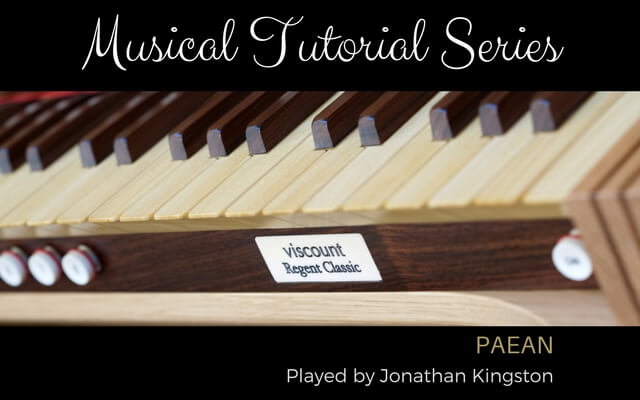Regent Classic’s musical tutorial videos for 2017 feature pieces from the ABRSM organ examination syllabus. Organist Jonathan Kingston gives you a short introduction to each piece, offering some background and tips about performance and registration.
See the Organ Music Tutorial Series overview for links to more organ videos and information about them. There you will also be able to read more about Jonathan Kingston and the organs being played in this series.
Paean by Philip Moore is a song of praise or triumph

Philip Moore’s Paean was written in 2010 as one of a series of works by contemporary composers included in the “Little Organ Book”, published by the Organists’ Charitable Trust in association with the Ralph Vaughan Williams Trust. It features on the ABRSM Grade 7 syllabus. A Paean is really a song of praise or triumph, sometimes used of old when a battle was won, so this gives us a good idea about the performance style and suggests that such a work should be played with some vigour.
Moore held the post of Organist and Master of the Music at York Minster from 1983 until his retirement in 2008, upon which occasion he was awarded the Order of St William by the Archbishop of York. His compositional output includes a number of splendid and sometimes challenging choral works, as well as many works for the organ. He is currently President of the Royal College of Organists.
Paean works best on 3 manual organ

As Jonathan Kingston explains in his introduction, challenges when performing this piece include getting your head around the 5/8 and 7/8 time signatures, as well as management of the organ. The piece works most successfully on a three-manual instrument, he suggests. Articulation is critical, marking the natural strong beats, and one should be careful to stick to a steady tempo no faster than implied by the Allegro marking, otherwise things can run away.
As you’ll hear on this recording, Jonathan’s registrations are typically bright, up to mixtures to begin with, playing on the Great (coupled in this case to Swell and Choir); moving to the uncoupled Choir for the second section, with a quieter yet still bright registration. In the transition towards the final section extra fullness is added from Swell reeds, playing on the Great, with a gradually opening swell box.
Reaching the main theme again at the end, we hear a somewhat stronger registration than at the start, up to Great mixtures and a full Swell, plus a few more Choir stops, supported by the addition of some pedal reeds. As with any registration scheme, though, you’ll have to work out what’s successful on your particular instrument, guided by the directions of the composer.
If you would like to watch the video tutorial right now – here it is:
I have had a passion for church organs since the tender age of 12. I own and run Regent Classic Organs with a close attention to the detail that musicians appreciate; and a clear understanding of the benefits of digital technology and keeping to the traditional and emotional elements of organ playing.



